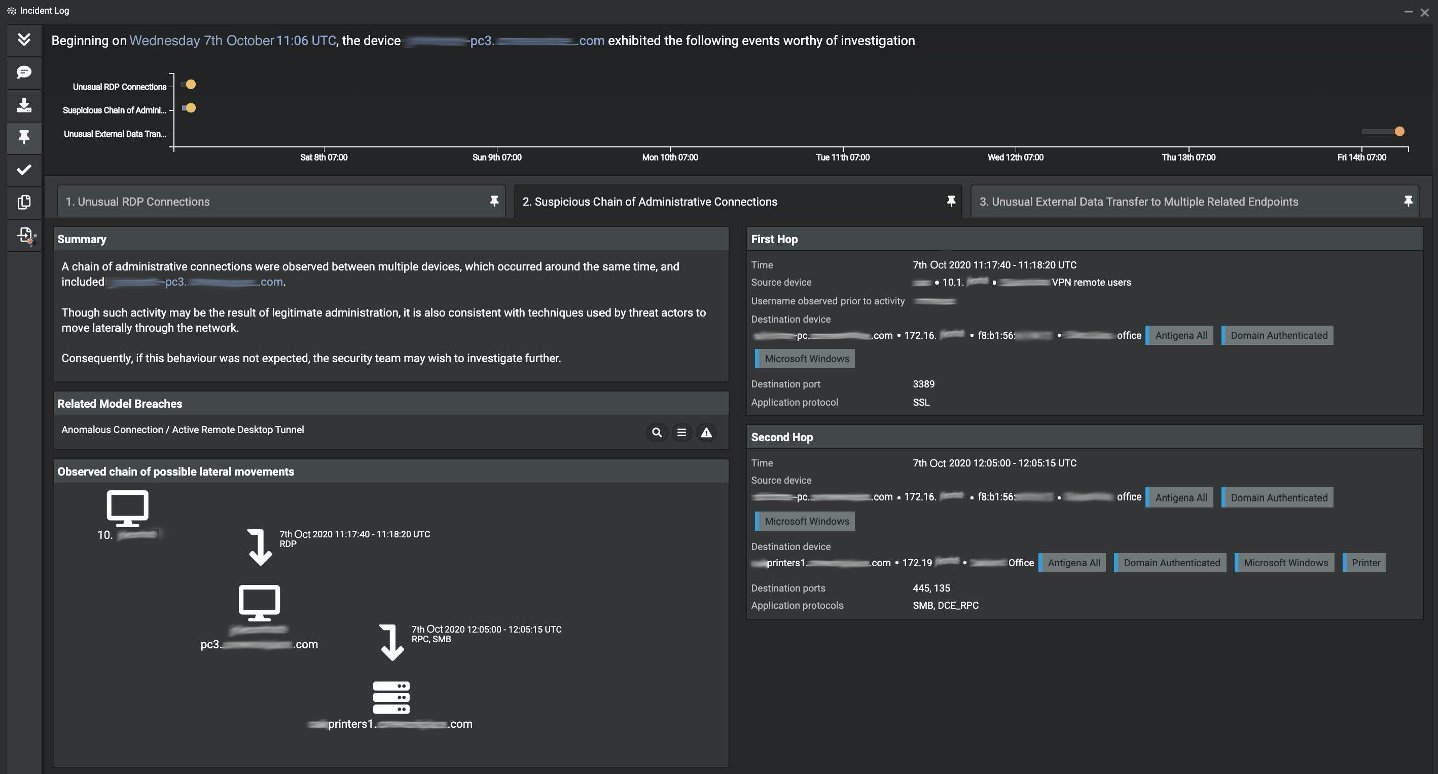Sodinokibi is one of the most lucrative ransomware strains of 2020, with its creators, cyber-criminal gang REvil, recently claiming over $100 million in profits this year alone. The prevalent threat is known to wipe backup files, encrypt files on local shares and exfiltrate data.
Exfiltration before encryption is a technique being increasingly adopted by profit-seeking cyber-criminals, who can threaten to leak the stolen data should a target organization not comply with their demands. Sodinobiki also makes heavy use of code obfuscation and encryption techniques to evade detection by signature-based, anti-virus solutions.
Darktrace’s AI recently detected Sodinokibi targeting a retail organization in the US. Prior to this year, the company operated primarily face-to-face in physical stores, but have conducted the majority of their business in the digital realm since the onset of the pandemic.
Cyber AI Analyst automatically launched a full investigation into this incident in real time, as the attack was unfolding. The technology provided summary reports of the entire incident which the security team could immediately action for incident response. This blog explores its findings.
Sodinokibi timeline
Darktrace automatically investigated on the full scope of the Sodinokibi attack, with Cyber AI Analyst clearly identifying and summarising every stage of the attack lifecycle, which played out over the course of three weeks as below:

Darktrace produced a large number of security-relevant anomalies associated with just three credentials, and displayed these along a common timeline shown below:

While a human analyst might have been able to identify these unusual patterns and investigate what caused the clusters of anomalous activity, this process would have taken precious hours during a crisis. Cyber AI Analyst automatically performed the same analysis using supervised machine learning trained on Darktrace’s world-leading analysts, generating meaningful summaries of each stage of the event in real time, as the incident unfolded.
REvil ransomware attack
The following events occurred during a free trial period, and Darktrace was not being actively monitored. Its Autonomous Response technology, Darktrace Antigena, was installed in passive mode, and in the absence of automatic interference at an early stage, this compromise was allowed to unfold without interruption. However, with Darktrace’s AI learning normal ‘patterns of life’ for every device in the background, identifying anomalies, and launching an automated investigation into the attack, we are able to go back into the Threat Visualizer and see how the incident unfolded.
The attack began when the credentials of a highly privileged member of the retail organization’s IT team were compromised. REvil is known to make use of phishing emails, exploit kits, server vulnerabilities, and compromised MSP networks for initial intrusion.
In this case, the attacker used the IT credential to compromise a domain controller and exfiltrate data directly after initial reconnaissance. Darktrace’s AI detected the attacker logging into the domain controller via SMB, writing suspicious files and then deleting batch scripts and log files in the root directory to clear their tracks.
The domain controller then made connections to several rare external endpoints, and Darktrace witnessed a 28MB upload that was likely exfiltration of initial reconnaissance data. Four days later, the attacker connected to the same endpoint (sadstat[.]com) – likely a stager download for C2, which was then initiated via connections on port 443 later that same day.
A week on from the intial C2 connection, a SQL server was detected engaging in network scanning as the attacker sought to move laterally in search of sensitive and valuable data. Over the course of two weeks, Darktrace witnessed unusual internal RDP connections using administrative credentials, before data was uploaded to multiple cloud storage endpoints as well as an SSH server. PsExec was used to deploy the ransomware, resulting in file encryption.
The evasive nature of modern ransomware
REvil started with an inherent advantage in that they were armed with the credentials of a highly privileged IT admin. Nevertheless, they still made several attempts to evade traditional, signature-based tools, such as ‘Living off the Land’ – using common tools such PsExec, WMI, RDP to blend into to legitimate activity.
They leveraged frequently-used cloud storage solutions like Dropbox and pCloud for data transfer, and they conducted SSH on port 443, blending in with SSL connections on the same port. They used a newly-registered domain for C2 communication, meaning Open Source Intelligence Tools (OSINT) were blind to the threat.
Finally, the malware itself was evasive in that it made use of code obfuscation and encryption, and had no need for a system library or API imports. This is the basis for most modern ransomware attacks, and the reality is signature-based tools cannot keep up. Darktrace’s AI not only detected the anomalous activity associated with every stage of the attack, but generated fleshed-out summaries of each stage of the attack with Cyber AI Analyst.
Cyber AI Analyst: Real-time incident reporting
Between September 21 and October 12, Cyber AI Analyst created 15 incidents, investigating dozens of point detections and creating a coherent attack narrative.

Figure 3: Cyber AI Incident log of the first compromised DC. This incident tab details the connections to sadstat[.]com

Figure 4: The DC establishes C2 to the first GHOSTnet GmbH IP

Figure 5: This incident tab highlights the file encryption of files on network shares

Figure 6: Darktrace surfaces the IT admin account takeover

Figure 7: Example of a client type device involved in extensive administrative RDP and SMB activity, as well as data uploads to Dropbox (this upload to Dropbox occurs few seconds before file encryption begins)
REvil vs AI
This Sodinokibi ransomware attack slipped under the radar of a range of traditional tools deployed by the retail organization. However, despite the threat dwelling in the retail organization’s digital environment for over a month, and REvil using local tools to blend in to regular traffic, from Darktrace’s perspective these actions were noisy in comparison to the organization’s normal ‘pattern of life’, setting off a series of alerts and investigations.
Darktrace’s Cyber AI Analyst was able to autonomously investigate nearly every attack phase of the ransomware. The technology works around the clock, without requiring training or time off, and can often reduce hours or days of incident response into just minutes, reducing time to triage by up to 92% and augmenting the capabilities of the human security team.
Thanks to Darktrace analyst Joel Lee for his insights on the above threat find.
Learn more about Cyber AI Analyst
Darktrace model detections:
- Anomalous Connection / Active Remote Desktop Tunnel
- Anomalous Connection / Data Sent To New External Device
- Anomalous Connection / Data Sent to Rare Domain
- Anomalous Connection / High Volume of New or Uncommon Service Control
- Anomalous Connection / SMB Enumeration
- Anomalous Connection / Uncommon 1 GiB Outbound
- Anomalous Connection / Unusual Admin RDP Session
- Anomalous Connection / Unusual Admin SMB Session
- Anomalous File / Internal / Additional Extension Appended to SMB File
- Anomalous Server Activity / Anomalous External Activity from Critical Network Device
- Compliance / SMB Drive Write
- Compliance / Possible Tor Usage
- Compromise / Ransomware / Ransom or Offensive Words Written to SMB
- Compromise / Ransomware / Suspicious SMB Activity
- Device / ICMP Address Scan
- Device / Multiple Lateral Movement Model Breaches
- Device / Network Scan
- Device / New or Uncommon WMI Activity
- Device / New or Unusual Remote Command Execution
- Device / RDP Scan
- Device / Suspicious Network Scan Activity
- Unusual Activity / Enhanced Unusual External Data Transfer
- Unusual Activity / Unusual Internal Connections







































